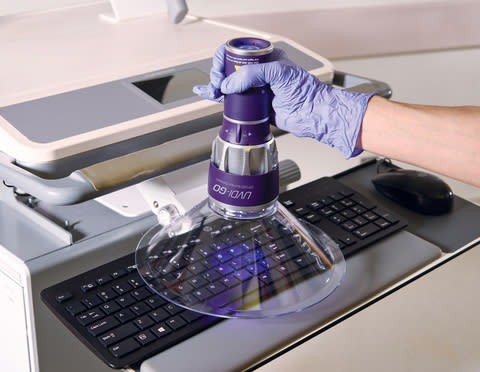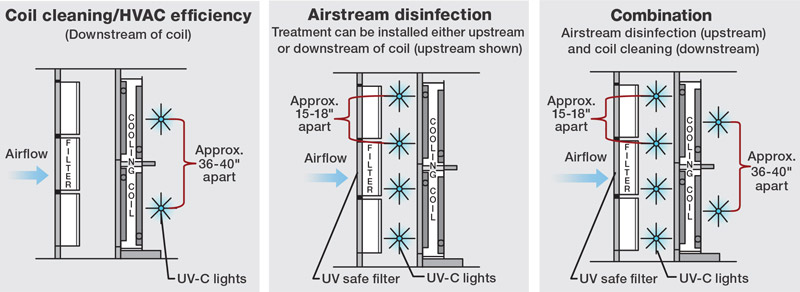Future-Proofing Your Space: Integrating UV Surface Disinfection for Ongoing Defense
Future-Proofing Your Space: Integrating UV Surface Disinfection for Ongoing Defense
Blog Article
UV Sanitation: The Cutting-Edge Innovation Transforming Cleanliness Practices
In the world of hygiene practices, one technology has actually emerged as a game-changer: UV sanitation. With its capability to get rid of dangerous pathogens, this sophisticated innovation is reinventing the method we approach cleanliness and health. However exactly how does UV disinfection job, and what are the advantages it uses? From healthcare setups to food processing, UV disinfection is making its mark in numerous markets. In this discussion, we will explore the intricacies of this transformative modern technology and expect its appealing future.
How UV Sanitation Works
UV sanitation functions by using ultraviolet light to destroy or suspend microorganisms, providing a chemical-free and extremely reliable technique of hygiene. This technology harnesses the power of short-wavelength UV-C light, which can harming the DNA and RNA of microbes, hence rendering them unable to trigger and duplicate damage.
The procedure begins with the setup of UV sanitation systems, which contain UV lights that send out UV-C light. These lamps are strategically positioned in areas where microbial contamination is a problem, such as water therapy plants, hospitals, research laboratories, and food processing centers.
When microorganisms are revealed to UV-C light, the photons permeate their cell walls and get to the DNA and RNA inside. The high-energy UV-C photons disrupt the genetic product by creating bonds between surrounding nucleotides, causing the development of thymine dimers. These dimers prevent the microbes from replicating, making them safe.
UV sanitation is highly effective against a large range of bacteria, consisting of parasites, bacteria, and viruses. It is especially effective versus waterborne pathogens like E. coli, Giardia, and Cryptosporidium. UV disinfection is a chemical-free technique, eliminating the need for potentially dangerous disinfectants and reducing the threat of damaging sanitation spin-offs.
Advantages of UV Disinfection
UV disinfection provides various benefits in the area of sanitation, making it an extremely liked technique for successfully removing harmful bacteria. One of the essential benefits of UV sanitation is its capacity to supply a chemical-free option. Unlike conventional disinfection methods that rely upon chemicals, UV sanitation makes use of ultraviolet light to ruin the DNA of microorganisms, making them incapable to duplicate and trigger infections. This not only removes the need for potentially damaging chemicals however also lowers the danger of chemical residue on surface areas.

UV sanitation is additionally highly flexible in its applications. It can be made use of in various settings, including health centers, schools, food processing facilities, and water therapy plants. UV sanitation systems can be conveniently integrated into existing cleanliness techniques, offering an extra layer of defense versus transmittable diseases.
Along with its effectiveness and adaptability, UV sanitation is also eco-friendly. It does not produce any type of unsafe byproducts or deposits, making it a sustainable and safe approach for sanitation - uv surface disinfection. UV disinfection requires very little maintenance and has a lengthy life expectancy, resulting in price financial savings in the long run.
UV Sanitation in Medical Care Settings
In healthcare settings, UV sanitation has emerged as a revolutionary approach for effectively removing hazardous bacteria. UV disinfection functions by producing ultraviolet light at a specific wavelength that is dangerous to germs, viruses, and various other microorganisms.
Firstly, UV sanitation is a non-chemical technique, making it an eco-friendly option compared to standard disinfection approaches that usually include the use of rough chemicals. Using UV light removes the need for chemical disinfectants, decreasing the danger of hazardous residue or chemical exposure to both clients and health care workers.
In addition, UV disinfection is extremely effective in killing a vast variety of microbes, including drug-resistant bacteria such as MRSA and C. difficile. It offers a trustworthy and consistent disinfection procedure, making certain that all surface areas and devices are completely decontaminated, even in hard-to-reach locations.

UV Sanitation in Food Processing
The application of UV disinfection extends beyond health care settings and finds considerable value in the realm of food handling. uv surface disinfection. UV disinfection innovation is coming to be increasingly prominent in the food market as a result of its capacity to properly get rid of damaging microorganisms and boost food security
Among the main advantages of UV sanitation in food processing is its capability to target a variety of microbes, consisting of infections, molds, and germs. By utilizing UV light at details wavelengths, it is feasible to disrupt the DNA and RNA of these virus, providing them unable to create or duplicate injury. This innovation can Get the facts be applied to numerous phases of the food processing chain, including surface area sanitation, equipment sanitation, and water treatment.
UV sanitation supplies a chemical-free and non-thermal approach of sanitizing foodstuff. Unlike standard sanitation approaches that count on chemicals or warm, UV technology does not leave any type of residue or modify the taste, appearance, or nutritional worth of the food. This makes it an ideal remedy for markets that require stringent adherence to high quality criteria.
In addition, UV sanitation systems are very easy to set up and run, requiring very little upkeep. They can be integrated into existing processing lines without creating considerable interruptions to the manufacturing process. Furthermore, UV systems have a fast treatment time, permitting continual handling and reducing downtime.
The Future of UV Sanitation

One location where UV disinfection is anticipated to make considerable innovations remains in the field of health care. With the increase of antibiotic-resistant microorganisms and the requirement for more effective disinfection methods, UV light has the prospective to play a critical function in reducing healthcare-associated infections. UV disinfection systems can be utilized to decontaminate surface areas, devices, and even the air in visit this site right here healthcare centers, helping to stop the spread of dangerous virus and enhance individual safety.
One more market that might profit from innovations in UV sanitation innovation is the food market. UV light has actually already verified to be an efficient technique for sanitizing foodstuff and minimizing the danger of foodborne diseases. As innovation improves, we can anticipate to see more efficient and cost-effective UV disinfection systems being executed in food processing plants, guaranteeing that the food we consume is secure and cost-free from dangerous bacteria.
Conclusion
Finally, UV sanitation is a cutting-edge technology that is transforming sanitation practices in medical care settings and food processing. By using UV light to eliminate or deactivate microbes, it offers various benefits such as safety and security, performance, and effectiveness. With continuous innovations in this area, UV sanitation holds wonderful potential for the future of hygiene, offering a sustainable and trustworthy remedy for maintaining tidy and hygienic settings.
UV sanitation is a chemical-free technique, removing the need for possibly hazardous anti-bacterials and reducing the danger of additional hints damaging disinfection spin-offs.
Unlike traditional disinfection approaches that depend on chemicals, UV sanitation makes use of ultraviolet light to destroy the DNA of microbes, rendering them incapable to replicate and trigger infections. Unlike standard sanitation methods that count on chemicals or warmth, UV innovation does not leave any kind of residue or change the preference, appearance, or nutritional value of the food. As innovation boosts, we can anticipate to see extra economical and reliable UV disinfection systems being executed in food handling plants, guaranteeing that the food we consume is secure and totally free from hazardous microorganisms.
In conclusion, UV sanitation is a sophisticated technology that is changing sanitation methods in medical care settings and food processing.
Report this page